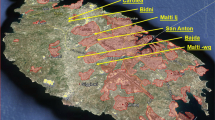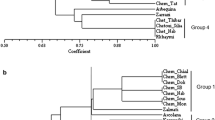Abstract
Málaga is a province of Spain where olive-trees are cultivated in a large range of environments, climates and soils. We have developed a reliable and reproducible method to detect RAPD and AP-PCR polymorphisms, using DNA from olive-tree (Olea europaea L.) leaves. Starting from their natural orchards, fifty-six olive-tree cultivars throughout Málaga province, including oil and table olive cultivars, were screened and grouped into 22 varieties. A total of 62 informative polymorphic loci that provide 601 conspicuous bands were enough to differentiate the varieties. Clustering analyses managing 3 different pairwise distances, as well as phylogenetic analyses, led to the same result: olive-trees in Málaga can be divided into three main groups. Group I (90% of certainty) contains wild type and two introduced varieties, group II (83% of certainty) covers some native olive-trees, and group III (58% of certainty) is an heterogeneous cluster that includes varieties originating and cultivated in a number of Andalusian locations. Geographic location seems to be the first responsible of this classification, and morphological traits are needed to justify the group III subclustering. These results are consistent with the hypothesis of autochthonic origin of most olive-tree cultivars, and have been used to support a Label of Origin for the olive oil produced by the varieties included in group II.
Similar content being viewed by others
References
Adams, R.P. & L.H. Rieseberg, 1998. The effects of non-homology in RAPD bands on similarity and multivariate statistical ordination in Brassica and Helianthus. Theor Appl Genet 97: 323-326.
Amstrong, J., A. Gibbs, R. Peakall & G. Weiller, 1994. The RAP-Distance package. http://life.anu.edu.au/molecular/sofware/rapd.html
Angiolillo, A., M. Mencuccini & L. Baldoni, 1999. Olive genetic diversity assessed using amplified fragment length polymorphisms. Theor Appl Genet 98: 411-421.
Apostol, B.L., W.C. Black, B.R. Miller, P. Reiter & B.J. Beaty, 1993. Estimation of the number of full sibling families at an oviposition site using RAPD-PCR markers: applicationss to the mosquito Aedes aegypti. Theor Appl Genet 86: 991-1000.
Asturias, J.A., M.C. Arilla, N. Gomez-Bayó n, J. Martínez, A. Martínez & R. Palacios, 1997. Cloning and expression of the panallergen profilin and the major allergen (Ole e 1) from olive tree pollen. J Allerg Clin Immunol 100: 365-372.
Barker, J.H.A., M. Matthes, G.M. Arnold, K.J. Edwuards, I. Åhman, S. Larsson & A. Karp, 1999. Characterisation of genetic diversity in potential biomass willows (Salix spp.) by RAPD and AFLP analyses. Genome 42: 173-183.
Barranco, D. & L. Rallo, 1984. Las variedades de olivo cultivadas en Andalucía. Consejería de Agricultura y Pesca de la Junta de Andalucía-MAPA, Madrid.
Batanero, E., A. Ledesma, M. Villalba & R. Rodríguez, 1997. Purification, amino acid sequence and immunological characterization of Ole e 6, a cysteine enriched allergen from olive tree pollen. FEBS Lett 410: 293-296.
Belaj, A., I. Trujillo, R. de la Rosa & L. Rallo, 1998. Selection of RAPD markers for olive (Olea europaea L.) cultivars identification. Acta Hort in press.
Bogani, P., D. Cavalieri, R. Petruccelli, P.L. & G. Roselli, 1994. Identification of olive tree cultivars by using random amplified polymorfic DNA. Acta Hort 356: 98-101.
Brousse, G., 1987. Olive. In: G. Robbelen, R.K. Downey & A. Ashri (Eds.), Oil crops of the world, their breeding and utilization, pp. 462-474. McGraw Hill Publising Company, New York.
Chevalier, A., 1948. L'origine de l'olivier cultivé et ses variations. Rev Internat Bot Appl Agric Trop 28: 1-25.
Claros, M.G. & F.M. Cánovas, 1998. Rapid high quality RNA preparation from pine seedlings. Plant Mol Biol Rept 16: 9-18.
del Río, C. & J.M. Caballero, 1994. Caracterizació n agronó mica preliminar de las variedades introducidas en el banco de germoplasma de olivo de Có rdoba en 1987. Frutic Prof 62: 9-15.
Demeke, T., R.P. Adams & R. Chibbar, 1992. Potential taxonomic use of random amplified polymorphic DNA (RAPD): a case study of Brassica. Theor Appl Genet 84: 990-994.
Dice, L.R., 1945. Measure of the amount of ecological association between species. Ecology 26: 297-302.
Doyle, J.J. & J.L. Doyle, 1987. A rapid isolation procedure for small quantities of fresh leaf tissue. Phytochem Bul 19: 11-15.
Dulson, J., L.S. Kott & V.L. Ripley, 1998. Efficacy of bulked DNA samples for RAPD DNA fingerprinting of genetically complex Brassica napus cultivars. Euphytica 102: 65-70.
Fabbri, A., J.I. Hormaza & V.S. Polito, 1995. Random amplified polymorphic DNA analysis of olive (Olea europaea L) cultivars. J Amer Soc Hort Sci 120: 538-542.
Felsenstein, J., 1981. Evolutionary trees from DNA sequences: a maximum likelihood approach. J Mol Evol 17: 368-376.
Felsenstein, J., 1988. Phylogenies from molecular sequences: inference and reliability. Annu Rev Genet 22: 521-565.
Felsenstein, J., 1993. PHYLIP (Phylogeny Inference Package) version 3.5c. Seattle, Distributed by the author. Department of Genetics, University of Washington.
Ferreira, A.R. & P. Keim, 1997. Genetic mapping of soybean [Glycine max (l.) Merr.] using random amplified polymorfic DNA (RAPD). Plant Mol Biol Rept 15: 335-354.
Ghérardi, M., B. Mangin, B. Goffinet, D. Bonnet & T. Huguet, 1998. A method tomeasure genetic distance between allogamous populations of alfalfa (Medicago sativa) using RAPD molecular markers. Theor Appl Genet 96: 406-412.
Gower, J.C., 1985. Measures of similarity, dissimilarity and distance. In: S. Klotz & N.L. Johnson (Eds.), Encyclopedia of Statistical Sciences vol 5, pp. 397-405. Wiley, New York.
Green, P.S. & G.E. Wickens, 1989. The Olea europaea complex. In: K. Tan (Ed.), The Davis and Hedge Festschrift, pp. 287-299. Edinburgh University Press, Edinburgh.
Haralampidis, K., D. Milioni, J. Sanchez, M. Baltrusch, E. Heinz & P. Hatzopoulos, 1998. Temporal and transient expression of stearoyl-ACP carrier protein desaturase gene during olive fruit-development. J Exp Bot 49: 1661-1669.
Huelsenbeck, J.P., 1995. Performance of phylogenetic methods in simulation. Syst Biol 44: 17-48.
Jaccard, P., 1908. Nouvelles recherches sur la distribution florale. Bull Soc Vaud Sci Nat 44: 223-270.
Jones, C.J., K.J. Edwards, S. Castaglione, M.O. Winfield, F. Sala, C. van de Wiel, G. Bredemeijer, B. Vosman, M. Matthes, A. Daly, R. Brettschneider, P. Bettini, M. Buiatti, E. Maestri, A. Malcevschi, N. Marmiroli, R. Aert, G. Volckaert, J. Rueda, R. Linacero, A. Vázquez & A. Karp, 1997. Reproducibility testing of RAPD, AFLP and SSR markers in plants by a network of European laboratories. Mol Breeding 3: 381-390.
Karsiotis, A., M. Hagidimitriou, A. Douka & P. Hatzopoulos, 1998. Genomic organization, sequence interrelationship, and physical localization using in situ hybridization of two tandemly repeated DNA sequences in the genus Olea. Genome 41: 527-534.
Lavee, S., 1990. Aims, methods and advances in breeding of new olive (Olea europaea L.) cultivars. Acta Hort 286: 26-36.
Loukas, M. & C.B. Krimbas, 1983. History of olive cultivars based on their genetic distances. J Hort Sci 58: 121-127.
Minet, M., M.E. Dufour & F. Lacroute, 1992. Complementation of Saccharomyces cerevisiae auxotrophic mutants by Arabidopsis thaliana cDNAs. Plant J 2: 417-422.
Nei, M. & W.H. Li, 1979. Mathematical model for studying genetic variation in terms of restriction endonucleases. Proc Natl Acad Sci USA 76: 5269-5273.
Nicese, F.P., J.I. Hormaza & G.H. McGranahan, 1998. Molecular characterization and genetic relatedness among walnut (Juglans regia L.) genotypes based on RAPD markers. Euphytica 101: 199-206.
Ochiai, A., 1957. Zoogeographic studies on the soleoid fishes found in Japan and its neighbouring regions. Bull Jap Soc Sci Fish 22: 526-530.
Ouazzani, N., R. Lumaret & P. Villemur, 1996. Genetic variation in the olive tree (Olea europaea L.) cultivated in Morocco. Euphytica 91: 9-20.
Ouazzani, N., R. Lumaret, P. Villemur & F. Di Giusto, 1993. Leaf allozyme variation in cultivated and wild olive trees (Olea eurpaea L.). J Heredity 84: 34-42.
Page, R.D.M., 1996. TreeView: an application to display phylogenetic trees on personal computers. Comput Applic Biosci 12: 357-358.
Pandey, R.N., R.P. Adams & L.E. Flournoy, 1996. Inhibition of random amplified polymorfic DNAs (RAPDs) by plant polysaccharides. Plant Mol Biol Rept 14: 17-22.
Pontikis, C.A., M. Loukas & G. Kousounis, 1980. The use of biochemical markers to distinguish olive cultivars. J Hort Sci 55: 333-343.
Rallo, L., 1994. Evaluació n agronó mica y obtenció n de nuevas variedades de olivo. Frutic Prof 62: 17-27.
Rubio, M.J. & P. Arú s, 1997. Un vivero españ ol, 'Agromillora Catalana', aplica en su producció n de planta de olivo un control de calidad genético y sanitario basado en las nuevas tecnologías de RAPDs y ELISA-DAS. Frutic Prof 88: 14-18.
Saitou, N. & M. Nei, 1987. The neighbor-joining method: a new method for reconstructing filogenetic trees. Mol Biol Evol 4: 406-425.
Strimmer, K. & A. von Haeseler, 1996. Quartet-puzzling: a quartet maximum-likelihood method for reconstructing tree topologies. Mol Biol Evol 13: 964-969.
Strimmer, K. & A. von Haeseler, 1997. Likelihood-mapping: a simple method to visualize phylogenetic content of a sequence alignement. Proc Natl Acad Sci USA 94: 6815-6819.
Trujillo, I., L. Rallo, E.A. Carbonell & M.J. Asins, 1990. Isoenzymatic variability of olive cultivars according to their origin. Acta Hort 286: 137-140.
Vergari, G., M. Patumi & G. Fontanazza, 1996. Utilizació n de los marcadores RAPDs para la caracterizació n del germoplasma de olivo. Olivae 60: 19-22.
Villalba, M., E. Batanero, R.I. Monsalve, M.A.G. Delapena, C. Lahoz & R. Rodriguez, 1994. Cloning and expression of Ole e 1, the major allergen from olive tree pollen-Polymorphism analysis and tissue-specificity. J Biol Chem 269: 15217-15222.
Welsh, J. & M. McClelland, 1990. Fingerprint genomes using PCR with arbitrary primers. Nucl Acids Res 18: 7213-7218.
Wiesman, Z., N. Avidan, S. Lavee & B. Quebedeaux, 1998. Molecular characterization of common olive varieties in Israel and the West-Bank using randomly amplified polymorphic DNA (RAPD) markers. J Amer Soc Hort Sci 123: 837-841.
Williams, J.G.K., M.K. Hanafey, J.A. Rafalski & S.V. Tingey, 1993. Genetic analysis using random amplified polymorphic DNA markers. Methods Enzymol 218: 704-740.
Yang, X. & C. Quiros, 1993. Identification and classification of celery cultivars with RAPD markers. Theor Appl Genet 86: 205-212.
Zohary, D. & M. Hopf, 1994. Olive: Olea europaea. In: Domestication of plants in the Old World, pp. 137-143. Clarendon Press, Oxford.
Author information
Authors and Affiliations
Rights and permissions
About this article
Cite this article
Claros, M.G., Crespillo, R., Aguilar, M.L. et al. DNA fingerprinting and classification of geographically related genotypes of olive-tree (Olea europaea L.). Euphytica 116, 131–142 (2000). https://doi.org/10.1023/A:1004011829274
Issue Date:
DOI: https://doi.org/10.1023/A:1004011829274




